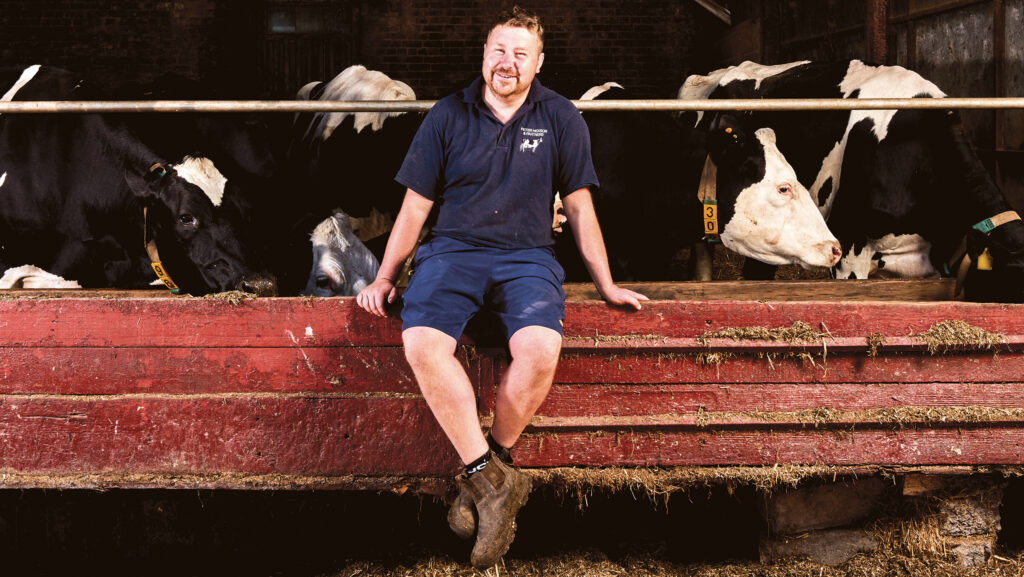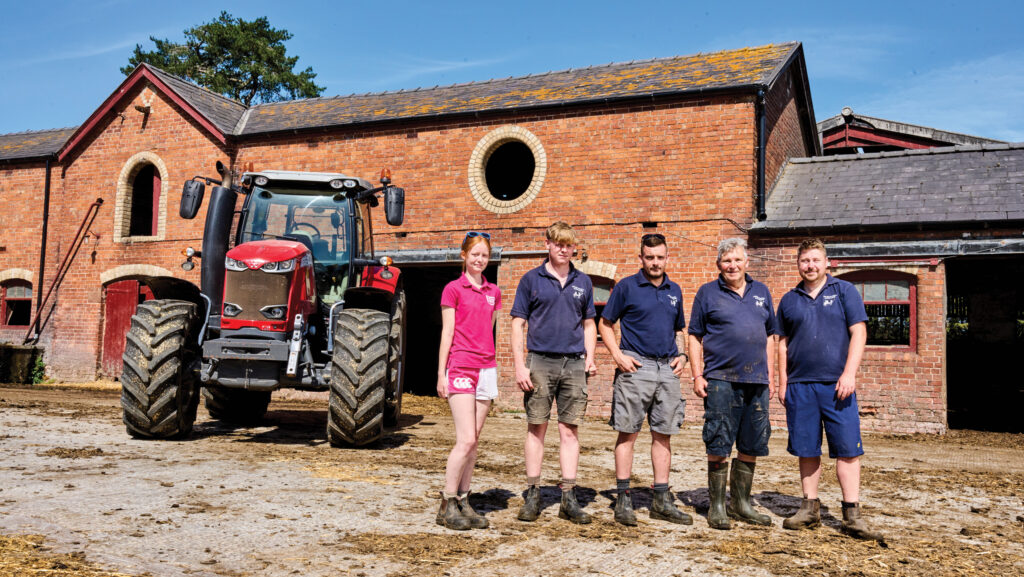How a hospitality career helped create a strong dairy team
 Harry Hickson © Oli Lees
Harry Hickson © Oli Lees Experience working in the hospitality sector has given Harry Hickson a fresh approach to dairy team management based on valuing and investing in people.
It was never Harry’s intention to return to the family farm – until he was made redundant from his job as a food and beverage manager during the Covid pandemic in 2020.
“I couldn’t find work so I said to my dad, could I come back and have a go, just to get some money and provide for my family,” he recalls.
See also: Top leadership tips to help dairy workforce thrive
What was meant to be a stop gap quickly turned into a passion, working from the bottom up, learning as he went.
Having decided to commit to dairy farming, investments were then made to secure the long-term viability of the business.
This has included installing a new parlour, upgrading cubicles, investing in cow activity monitors and increasing cow numbers from 160 to 280 in-milk.
Two out of three existing staff left early on, leaving Harry, dad Peter and a new apprentice, Harvey Clapton (then 16) with support from relief workers.
With herd expansion, today’s team is made up of herdsman, Tom Roberts; Harvey as head of youngstock; and apprentices Rebecca Edwards, 17, and Harley Green, 16, plus relief.
Farm Facts
Kilhendre Farm, Ellesmere, Shropshire
- 113ha farmed, with 20ha maize, 8ha wholecrop and the rest grass
- 310 Holstein Friesians
- 9,500 litres a cow a year at 4.2% fat and 3.3% protein
- 3,500 litres a cow a year from forage
- Supplying Muller Tesco
- Harry Hickson is a Muller Next Generation farmer
- Sexed dairy semen and part of Warrendale Wagyu beef scheme
Fresh perspective
When Harry returned to the business, he recognised that the team was close to burnout from working long hours.
He also noted a mentality within the industry where people were expected to “know the job” or do it in a certain way.
As a result, he has adopted a management approach that invests in the right people through training and flexible working hours.
He says if people are not getting enough breaks or refreshing their minds, challenging themselves, they become very stagnant.

Left to right: Rebecca Edwards, Harvey Clapton, Tom Roberts, Peter Hickson, Harry Hickson © Oli Lees
Ultimately, the aim is to attract and retain people with a view to driving productivity.
“It’s important to us to keep hold of our staff. If we had to find people, it would cost us a lot of time, money and efficiency,” he explains.
This has been achieved in the following ways:
1. Adapting working rotas
“We don’t work on ‘bare-bones’ staff, we work on one extra, and the way we do that is with self-employed workers,” Harry explains.
This means everyone will work a maximum of two mornings in a row starting at 4.30am. Overtime is also paid between 4.30am and 8am and after 6pm, based on 39 hours/week and an hour of overtime.
Following feedback, Tom does not start work until 9am on the Monday after a weekend on. His hours have also been adjusted to fit with family life.
Harry believes ensuring people are well rested is essential, particularly considering the long days and stress of farming, often coupled with family life.
“When they’re here, they’re fresher and focused,” he adds.
2. Taking on apprentices
Having always “planned for a rainy day” in hospitality, he made the decision to take on an apprentice early on to ease the pressure on the team.
“I felt we needed to take someone on to learn the role and help us,” he explains.

© Oli Lees
Harvey was the farm’s first apprentice and has since returned full time. This year, with the larger herd, two have been taken on.
The aim is to bring apprentices into the business and provide scope for Peter to cut back his hours when needed.
Harry believes it is better to use apprentices and train them in how he wants things done, rather than employing people who may already have bad habits.
He says recruiting people with the right attitude and openness to improve is also key, as well as providing the right environment.
“If the culture in the business isn’t right, and you’re trying to put an apprentice in a business that’s not ready, it will be difficult for them to flourish,” he adds.
3. Training
One of the main lessons Harry has learned from hospitality is having an openness to train people and create flexibility so they can provide cover when others are away.
Tom has a background in buildings and construction so required training to take on the role of herdsman.
This has included doing artificial insemination and foot-trimming courses.
The team is also encouraged to go on farm walks and challenged to bring back one idea that can be implemented on-farm to improve the business.
4. Rewarding staff
The team will be moved up the pay bands as they undertake specific training courses.
As upper pay bands have been met, Harry has looked at rewarding people in different ways to suit their interests and motivations.
For example, Tom is a keen fisherman, so a pond has been dug out on the farm and populated with fish, which means he can go fishing and take the family if he wishes. This gives good “buy-in” to the farm.
5. Giving staff specific responsibilities
Giving staff a title and set responsibility makes them feel valued and encourages them to take pride in their work.
For example, when Harvey started full-time, he was given the title head of youngstock and has been provided with appropriate training along the way.
“If you want a good culture and to attract people, let your staff have buy-in and responsibility,” Harry says.
Being open to people’s ideas is also fundamental to creating a good team culture.
“We try to put more faith in our staff to make suggestions and question elements: could we do this better or that better?” Harry says.
Tips for creating a good farm culture
Creating the right farm culture is “massive” when it comes to retaining and attracting staff on dairy farms, says Kaia Hillsmith, consultant for Kite Consulting.
“Culture is everything as it’s what you’re working in every day,” she says, adding that if it is not right, staff will go and find somewhere where it is.
“People don’t leave jobs, they leave people, and that is all tied into culture and who you’re working with.”
The fact that other industries are taking it seriously also means it is no longer something farmers can ignore.
Kaia says what defines a good culture will differ from one person to another, but is ultimately about establishing an environment where people feel listened to and valued.
“It comes from the top down,” she adds.
She provides eight tips for creating a good farm culture:
1. Make time for people
Make time to listen to people and be consistent and genuine. That might mean a coffee after morning milking to run through the plan for the day or simply to listen.
The meeting does not need to be formalised, but set a regular time (preferably daily) and an expectation that everyone attends.
Also key is letting people feel comfortable giving feedback. This often starts with offering feedback.
One-on-one meetings every six months to listen to concerns and run through how people have performed is also valuable.
Always ask for feedback about what works well in their role and what they would do differently.
2. Provide staff with a space to call their own
A staffroom or space to call their own should be a bare minimum. Ensure it is clean, comfortable and large enough for the whole team, with enough seats for everybody.
Wellies should be left outside: people are more likely to maintain a nice space, and those living on-site are more likely to use it rather than go home at break-time.
This helps create a team environment.
3. Get everyone to buy-in to a vision
Involve the team in making decisions or changes where appropriate.
For example, if calves are not performing well, and the type of milk replacer needs to be changed, involve them in selecting a new one.
They are then more likely to share ideas. Share costings such as feed costs so they can see in real terms what they are working for.
Drawing together a vision statement or business goals for the year can also help with buy-in.
4. Deal with problems quickly
How issues are dealt with will have a huge impact on team dynamics and culture.
Problems left to fester can lead to blame culture.
Instead, they should be depersonalised and dealt with quickly: schedule a meeting with the relevant person to discuss issues, explain what the meeting will be about and ensure any conversations are in work time.
Listen to them and tailor a response according to the situation.
5. Avoid acting negatively towards people
Count to 10 before reacting. As a manager, avoid complaining to employees about other staff, as it suggests this is acceptable. Instead, be disciplined and do not whinge.
6. Show appreciation
People often receive feedback when they have done something wrong, but it is important to also ensure that praise is given when it is done well.
Giving the team a set budget for events and letting them decide what to spend it on can also help create a good working environment. However, this will not fix an already fractured team.
7. Have a structured on-boarding process
Everyone should have a clear role with outlined responsibilities. By setting expectations from the start, people are more likely to feel comfortable and confident in their roles.
8. Provide clear routes of progression
Provide clear job titles with defined roles and outline routes for progression.
For example, if a member of the team wants to start calf feeding or drying cows off, set out certain criteria they need to hit or training they need to do before they can start, and pay rewards.
